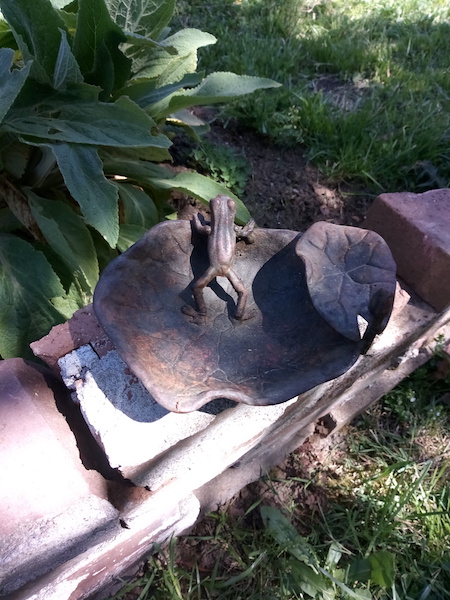Frog Dish
“Like an ancient map, its spirit roads in the visible realm can, effectively, never be found. A dish, about the size to fill two slightly cupped hands. Narrow, vaguely circular, disappearing from not only view but from longing itself, into the pinkish shadows beyond the treehouse, a kind of context it carries as an outer skin.”—Anita Sullivan
On the Other Hand
By Anita Sullivan

EUGENE Oregon—(Weekly Hubris)—May 2021—When it shows up again after five years, the object surprises you because it is so small. Yet even as you are confronting it from the almighty distance of your head, you realize it is duplicating itself every few seconds into a space slightly higher than before, as if rising through a forest of trees with enormous leaves, which it aspires to ingest one by one so as to appear simultaneously in as many dimensions as possible.
Fulness soon intact, the object continues to press relentlessly upwards from the brick on which it was set down somewhere in a very oblong past, until it hovers just at the level of your nose and then settles back onto the brick. All this occurs quickly but distinctly and thoroughly as a part of whatever might occur next, not merely as a set of tiny, imagined movements lacking the sanction of space or time.

Copper and charcoal are its colors, bleeding into one another tenderly in the way of old, found objects in antique shops or buried for years in the dirt. The surface makes you cough a little in defense against the nature of its scoured beauty, before which your heart and stomach are especially vulnerable. Like an ancient map, its spirit roads in the visible realm can, effectively, never be found.
A dish, about the size to fill two slightly cupped hands.
Narrow, vaguely circular, disappearing from not only view but from longing itself, into the pinkish shadows beyond the treehouse, a kind of context it carries as an outer skin.
Now, finally, you see that the object is a leaf with a frog on it, slightly overlapped on one side by a second, smaller leaf out of which has shot up, a furled blossom. The whole thing made of copper, you decide, though you have not touched it yet, even as your eyes feast upon the nature of its disintegration, which has been going on far longer than any original polished glow that might even have allowed you the small pleasure of a reflection, as if it were a copper mirror.
You must not know too much, only
gawk and move on, replete with bathing and drinking from an object meant for bees, dragonflies, beetles, perhaps even spiders—a huge mythology of first responders to the call for flagrant waters.
No matter when you return, it may or may not be here.
![]()
To order Anita Sullivan’s books, The Rhythm Of It and/or And if the Dead Do Dream, click on the book covers below.




2 Comments
Will
Anita, I love this poem; I love this object. Thank you for the full moment.
Anita Sullivan
Will, you are so very welcome. Your reply is a full moment for me.